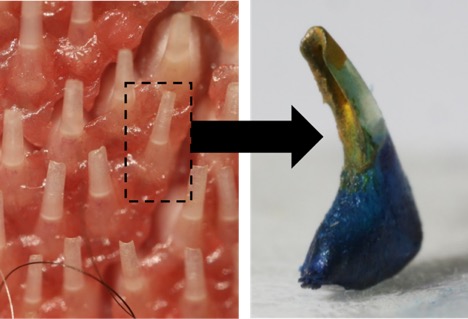How biomechanics research led to a hairbrush inspired by a cat tongue
Why does a cat groom so effectively with a sandpaper-like tongue? For the average person, this thought might prompt a quick Google search, but when thinking like a biomechanics researcher, this and other questions become research projects.
Thanks to Dr. Alexis Noel of the Georgia Tech Research Institute, a Google search might turn up an adequate answer. She was watching her parents’ cat as it licked a microfiber blanket when all of the sudden it got its tongue stuck. Sandpaper doesn’t get stuck, but Velcro does, thought Noel. This funny scene is what inspired Noel to study the biomechanics of cat tongues and get to the bottom of their effectiveness.
“The tongue is very multipurpose, very efficient at what it does,” explains Noel. “We wanted to investigate the grooming aspect because we were fascinated by the spikes we saw on the tongue.”

Seen here is cat tongue papillae. — Photo by Dr. Alexis Noel/Georgia Tech Research Institute.
Noel presented her findings of her cat tongue study, as well as the findings of her research on frog tongues and otter paws, to a room packed full of University of Akron’s young scientists on Feb. 7. The presentation was part of the University’s weekly Integrated Bioscience Seminar Series hosted by the Integrated Bioscience Ph.D. Program.
A shared trait among cats of all sizes
With the help of CT-scanning, high-speed video and some grooming technology built by Noel and her team, she found that these spikes at the front of the tongue were stiff, rigid scoop-shaped papillae (rounded projections on a part of the body). Surprisingly, Noel found that these papillae appear to be the same size on the tongues of all cats — they are just as effective at grooming a house cat as they are a lion.
“The spines are needed to push past hair clumping issues and be able to distribute fluid down to the root of the hairs to fully clean the hair of blood, dirt and oil,” says Noel. Because her research discovered how and why these papillae are so good at grooming, she used a 3D printer to model a hairbrush after a cat tongue.
The hairbrush is currently in the patent-approval process, and Noel anticipates its many applications. She is most excited for the brush to be used in veterinary practices to apply dermal medication to cats, but the brush could also be used to apply allergen-fighting shampoo. This means that a tongue-inspired hairbrush could reduce allergens in the home and make inviting over any allergic friends guilt-free.
Noel’s talk was just one of several seminars from the series sponsored by the Biomimicry Research and Innovation Center. The University was proud to host Noel, whose work has been featured in publications such as The Economist, The New York Times and National Geographic.
Read more about upcoming seminars from leading scientists.
► Story by Madeline Myers
► Media contact: Lisa Craig, 330-972-7429 or lmc91@uakron.edu
